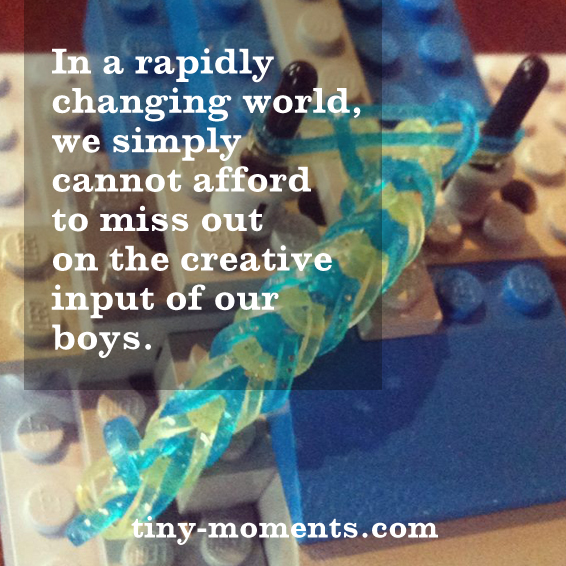Creativity is not just a Girl thing!
Marketers take note – words are powerful!
For quite a while now I have been researching and thinking about this question:
Why do all preschool kids accept that they are creative, but by the time they end primary school, most kids don’t?
There are many factors at play, but one of them hit home last week, when I attended the Kids Business Bloggers Brunch.
One of the brands exhibiting was the innovative toy/stationery company, Crayola. As a lover of anything that encourages kids’ creativity, I was keen to check out their exciting new products (some of which I will review in a separate post).
However, the poor Crayola rep I spoke to was also subject to one of the unexpected benefits of meeting with bloggers in person… I gave her a piece of mind – politely, of course!
I found their “Creations” product range, aimed at tween girls, rather disturbing.
At the time, the thing that annoyed me most was that this range was the only one that included glitter pens – a much coveted item by my boy. Being packaged up in fuschia pink automatically wiped the Crayola glitter pens off the Santa list! Let’s face it, no self-respecting boy wants something pink, despite his Mum’s best efforts to convince him otherwise.
It was only when I got home that I really understood why I was so upset. It wasn’t just that it was yet another example of “pinkification” of kids’ products as a marketing strategy. It was the use of the word “CREATIONS”.
The recent adoption of Loom Bands by boys in almost equal numbers as girls is, I believe, pretty convincing proof that boys enjoy creating things just as much as girls. Even my son, who normally shuns most craft activities, has been hooked! (Check out his Lego loom, pictured above, which he and Hubby built together.) Loom Bands were everywhere when I went shopping the other day, and it was interesting to note that they do NOT come in pink packaging. One brand even prominently featured a young boy, proudly displaying his creations on his wrist.
Yet toy companies are constantly sending out the message to our boys and their parents that “being creative”, especially in an art/craft sense, is something only girls do.
It reminded me of a story I had recently read in Brene Brown’s excellent book, Daring Greatly. In it, she tells of being approached by a middle-aged man who, as a child, had loved to draw and dreamt of being an artist. One day, his uncle visited and, within the young boy’s hearing, suggested to his brother that he was “raising a poofter”. Not only was he then discouraged by his father from drawing, but even as a grown man, he had never pursued his love of art. He was too ashamed.
This one example (and there are many, many others) points out just how careful we need to be when choosing the words that help shape our children’s identities.
If the word “CREATION” is made exclusively feminine, where does that leave our young male artists, writers, actors, dancers, musicians, film makers, designers, architects, engineers and entrepreneurs? For starters, have you ever tried to find a good journal or notebook for boys to record their creative ideas? It’s almost impossible!
Throughout history, our culture has been shaped by creative MEN. Think Shakespeare, Tennyson, Oscar Wilde, Tolkien, Mozart, Beethoven, Leonardo Da Vinci, Salvador Dali, Pablo Picasso, Fred Astaire, Rudolph Nureyev, Stephen Spielberg, Jim Henson, Freddie Mercury, Jimi Hendrix, even (dare I admit it) Justin Bieber! The sexual preference of these men (and I have deliberately chosen a mix of straight and gay men in this list) is irrelevant. Women have only had their status as creative influencers recognised in more recent years.
The urge to create is one of the most basic elements of humanity, male and female. It is also the key to solving some of our most challenging problems.
In a rapidly changing world, we simply cannot afford to miss out on the creative input of our boys.
(Sorry Crayola… I loved the rest of your product range. I will make it up to you!)

